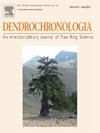Cork-ring width responds to climate depending on local site dryness
IF 2.7
3区 农林科学
Q1 FORESTRY
引用次数: 0
Abstract
Cork, the bark of cork oak (Quercus suber), is a major non-wood forest product in the Mediterranean Basin, but its future production will depend on forecast warmer and drier conditions. The comparison of topographically contrasting sites, subjected to different soil water availability, may be used as an analogous situation to projected aridification. We quantified cork and wood production and cork responses to climate variability and drought indices at dry (slope ridge) and wet (valley bottom) sites located in a relict cork oak population in north-eastern Spain. We also calculated intrinsic water-use efficiency cork (iWUE) by analysing C isotope ratios (δ13C) in annual cork samples. In the wet site, tree- and cork-rings were wider than in the dry site, where cork δ13C and iWUE were higher, particularly during moderate droughts. Cork and radial growth covaried in both sites and the slopes of their linear regressions were similar between dry and wet sites. In the dry site, cork width increased as June-July soil moisture did, whereas cork iWUE decreased as May soil moisture increased. Moist soil conditions in the prior October and March also enhanced cork growth at both sites, whilst wet prior winter conditions reduced cork iWUE at the dry site. Our findings show how cork production depends on local soil water availability. Cork δ13C can be used and combined with wood information to trace the physiological status of cork oak trees in response to drought stress.

软木环的宽度根据当地的干燥程度对气候做出反应
软木,即栓皮栎(栓皮栎)的树皮,是地中海盆地主要的非木材林产品,但其未来的产量将取决于预测的温暖和干燥的条件。地形上不同地点的比较,受到不同土壤水分的影响,可以用作预测干旱化的类似情况。我们量化了位于西班牙东北部一个废弃栓皮栎种群的干(坡脊)和湿(谷底)地点的软木和木材产量以及软木对气候变率和干旱指数的响应。我们还通过分析年度软木样本中的C同位素比率(δ13C)计算了软木的内在水利用效率(iWUE)。在湿润样地,树环和软木环比干燥样地更宽,软木环的δ13C和iWUE更高,特别是在中度干旱时。两个地点的软木和径向生长共变,其线性回归斜率在干湿地点相似。在干旱区,软木宽度随6 - 7月土壤湿度的增加而增加,而软木iWUE随5月土壤湿度的增加而减少。十月前和三月前的潮湿土壤条件也促进了两个地点的软木生长,而冬季前的潮湿条件降低了干燥地点的软木iWUE。我们的研究结果表明,软木塞的生产如何取决于当地的土壤水分供应。软木δ13C可以与木材信息相结合,追踪栓皮栎在干旱胁迫下的生理状态。
本文章由计算机程序翻译,如有差异,请以英文原文为准。
求助全文
约1分钟内获得全文
求助全文
来源期刊

Dendrochronologia
FORESTRY-GEOGRAPHY, PHYSICAL
CiteScore
5.50
自引率
13.30%
发文量
82
审稿时长
22.8 weeks
期刊介绍:
Dendrochronologia is a peer-reviewed international scholarly journal that presents high-quality research related to growth rings of woody plants, i.e., trees and shrubs, and the application of tree-ring studies.
The areas covered by the journal include, but are not limited to:
Archaeology
Botany
Climatology
Ecology
Forestry
Geology
Hydrology
Original research articles, reviews, communications, technical notes and personal notes are considered for publication.
 求助内容:
求助内容: 应助结果提醒方式:
应助结果提醒方式:


